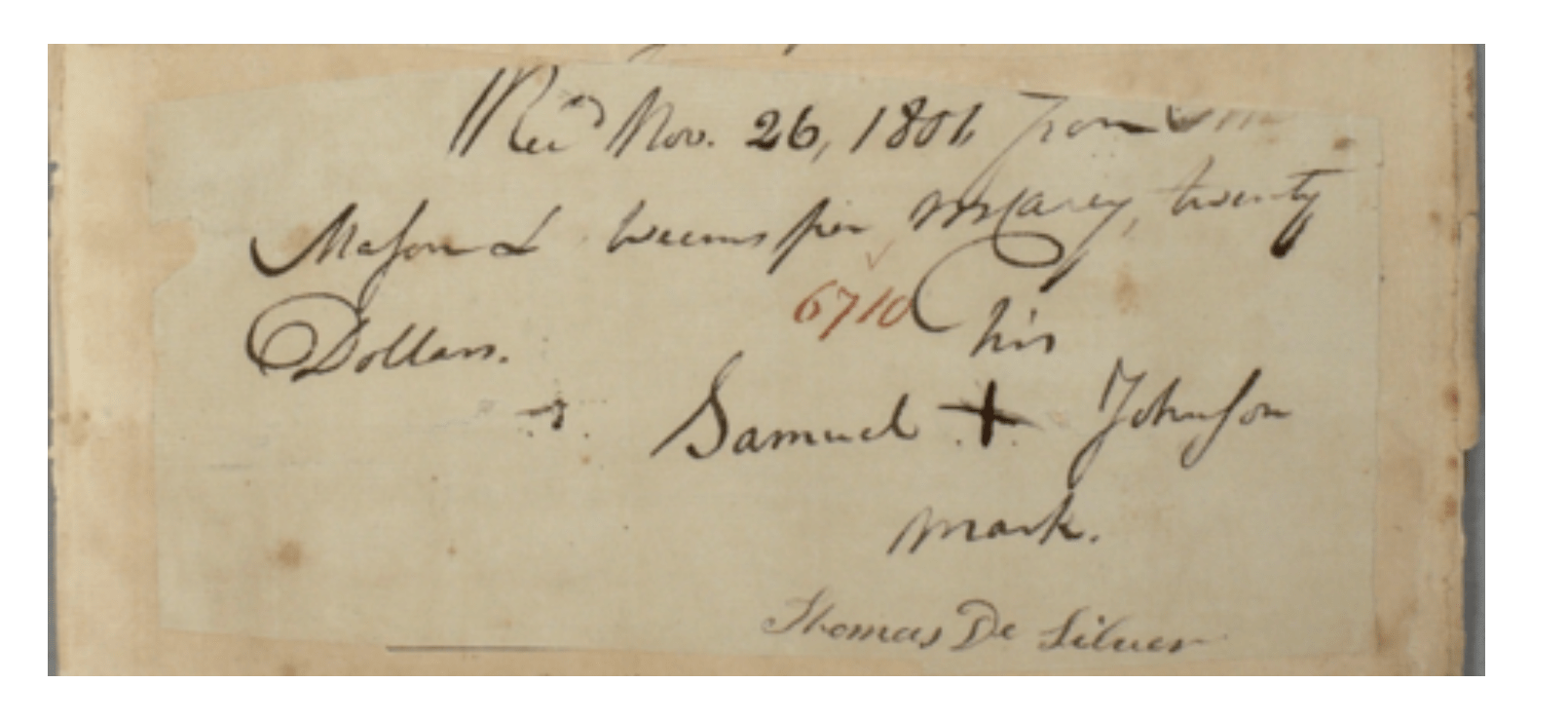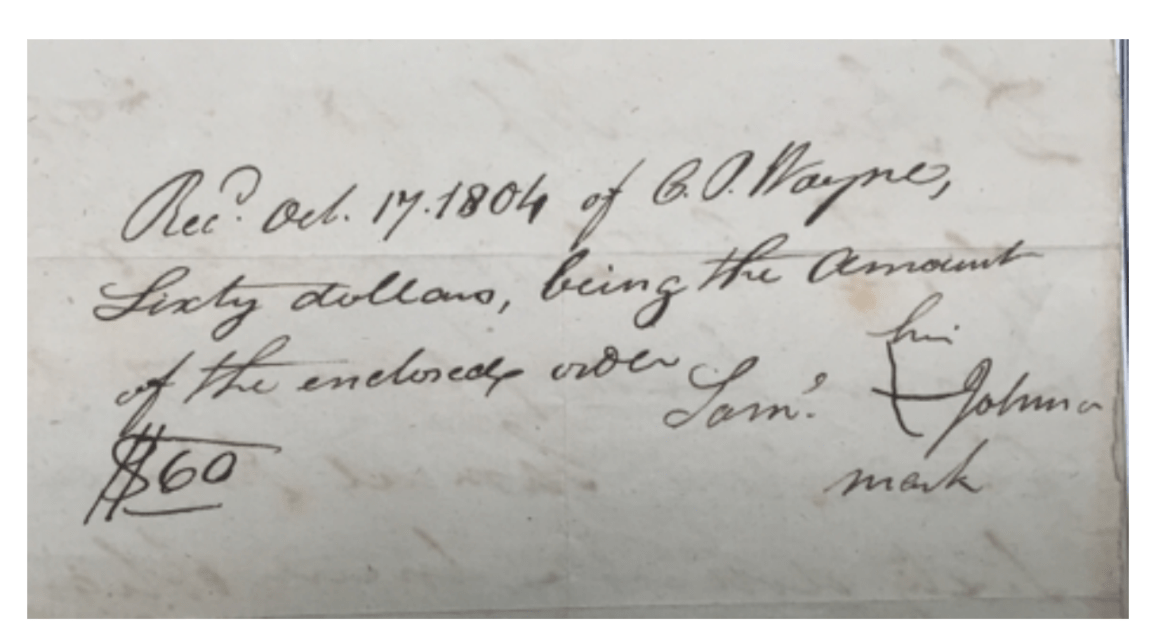by guest contributor John Garcia
Much of the pleasure of studying the economics of book publishing comes from the various minor personages who appear and disappear before the historian’s gaze. Sometimes patterns emerge from these fragmented discoveries, perhaps not enough for an article, but worth sharing as a provocation for others tilling similar ground. The anecdotes and interpretations supplied below represent a book historian’s contribution to recovery work in early African-American print culture. The study of early black print has benefited from new archival discoveries and interpretations, led in part by Cohen and Stein’s 2012 edited collection Early African American Print Culture. Rather than seek forgotten black authors or readers, or under-appreciated connections between print and racialization, I ask a set of questions that focus on the labors behind book culture in the early American republic: What happens in the vicinity of book production and consumption? Is there a black presence in the mundane life of making books (as opposed to writing, printing, or reading them)? How did African-Americans contribute to the various activities that support a printing operation or bookstore?
Focusing on activities occurring “in the vicinity” of book production directs attention to the still-unknown history of African-American labor, both free and enslaved, in relation to the early national book trade. Could indentured labor in a print shop allow enslaved persons a pathway to freedom? Was working for the book trade particularly amenable to emancipated African-Americans, even if they were illiterate?
Not long ago, while studying letters exchanged between Mathew Carey and his traveling agent Mason Locke Weems— the most successful American publisher prior to 1830 and the early republic’s most successful book marketer, respectively—I was given pause by the following query written by Weems in 1797:
“If you see my Sam (freed Negro) be so good as to tell him I want to employ him.”
This note was the first tantalizing clue I had ever seen about the presence of African-American workers in the print shops and publishing houses of Carey’s Philadelphia.
Samuel Johnson was a slave Weems had inherited as part of his father’s Maryland estate. Sam’s unusually literary name immediately brings to mind the famous English writer and biographer, and Weems may have personally chosen this name, given his own reputation as biographer and hagiographer of George Washington and others. Weems deserves credit for having freed Johnson—he elsewhere boasts to Carey of being an “early Liberator of my Slaves”—and he seems to have taken special care to ingratiate the ex-slave into the community of Philadelphia printers and publishers. Four years after receiving that first note from Weems, Carey paid Johnson twenty dollars on Weems’s account. Throughout the rest of the decade, Samuel Johnson appears in the financial records of Philadelphia publishers as a paid laborer, usually in the form of receipts bearing his mark. Johnson was illiterate.

Receipt of payment from Mathew Carey to Samuel Johson, Nov. 26, 1801. (Account #6710, Matthew Carey Papers, American Antiquarian Society)
Although sometimes portrayed as an ideologist of slavery and nationalism—here I’m thinking particularly of François Furstenberg’s compelling reading of Weems in In the Name of the Father (2006)—surviving evidence of the relationship between Weems and Johnson suggests that the former went out of his way to treat his ex-slave as an independent agent in the world of print.
Further evidence comes from a letter Weems wrote to the Philadelphia publisher C.P. Wayne: “Dr Sir. Of the little monies of mine now in your hand, please pay my Freed Man, Samuel Johnson Esq., sixty dollars & forever oblige two of your very ob’t serv’ts. Poor Sam & his Quondam Sovereign, M.L. Weems.”

Receipt of C.P. Wayne, Oct. 17, 1804 bearing Samuel Johnson’s mark (American Antiquarian Society)
On the verso of this letter, Wayne had Johnson sign his mark to acknowledge receipt of the sixty dollars. This large sum of money was for services Johnson performed in relation to Wayne’s publication of John Marshall’s five-volume Life of George Washington (1804-07), one of the most ambitious publication events of the decade. More evidence of Johnson’s labor can be found in the records of the female printer Lydia Bailey. In 1808, Bailey paid Sam $1.50 for “additional paveing in the yard in north alley” (Lydia R. Bailey Receipt Book, 1808-1824. American Antiquarian Society). This small sum, and the kind of labor expended to earn it, demonstrates that Weems was not exaggerating in calling his friend “Poor Sam.” Johnson undoubtedly took on the most menial, unskilled jobs from his Philadelphia employers.
Taken together, these documents give oblique information about the book trade’s reliance upon African-American labor. As early as 1797, Johnson seems to have frequently hung around the vicinity of Carey’s business. Johnson’s continued usefulness to Philadelphia’s printers is proven by the range of years (1801-1808) represented by the receipts. Illiterate men could perform valuable work in early U.S. print shops, binderies, bookstores, and paper mills, down to the mundane (but still necessary) work of building maintenance. These peripheral activities remind us that book historians should always consider the non-textual labors behind print culture that don’t end up on the page. Personal connections mattered as well, since it’s clear that Weems’s extensive contacts enabled Johnson to find employment and to be eventually paid. The men and women of the Philadelphia book trade comprised a close-knit community, as Rosalind Remer discusses in her 1996 book Printers and Men of Capital, and all three of Johnson’s employers had longstanding ties with Weems and with one other. This “network” of booksellers and printers kept Johnson involved, even though he couldn’t read the very books that his work helped to produce.
Samuel Johnson was likely an anomaly as a free African-American worker in the trade. My second example offers a glimpse into slave labor in a New York printing establishment. The records of the printer Samuel Campbell reveal 1790s New York as a city of print still rooted in the craft relations of the hand-press period. Campbell employed numerous apprentices, a practice documented by extant indentureship papers such as one contracted with a white boy named Alexander McLeod, aged fifteen, to learn the art of bookbinding. Also among Campbell’s papers is another indentureship for “Charles a negro man,” aged thirty-eight, to serve “after the manner of a servant.” Both contracts, for McLeod in 1791 and for Charles in 1793, reveal the different modalities of unfree labor used in early U.S. printing establishments.
How did Charles come to work for Campbell? A separate sheet of paper mounted to his indenture bears the signature of a previous owner, Casper Springsteen, who transferred the right to “bargain, sell, and dispose of” the slave to a relative David Springsteen, of Long Island, New York. On November 9, 1793, David Springsteen signed the papers that made Charles a servant of Samuel Campbell. The verso of the contract has a further note from David Springsteen directing Campbell to no longer consider Charles as the property of the Springsteen family after the expiration of seven years: “Provided the said Charles within named shall & do well and truly fulfill the written Indenture I do hereby remiss release and for ever quit claim unto the said negro slave & forgo any right of property over him.” Could this mean that Charles became a free man after termination of the indentureship? Unfortunately, the trail of evidence ends here, and I have not seen further mention of Charles in Samuel Campbell’s papers.
Campbell saw fit to use the same printed form for a black slave that he used for his white apprentices, even as the manuscript annotations and alterations made to Charles’s papers display his liminal status. As the property of another, slaves couldn’t legally bind themselves to an indenture, and yet his previous owner, David Springsteen, seems to have purposely inserted language endowing Charles with a provisional right to “fulfill the written Indenture” and work his way to freedom after a stated number of years. The difference between the contracts signed by Alexander McLeod and Charles, therefore, resides in different degrees of being bound to a master, with racial difference (in the case of Charles) calling for contractual finesse that was both emancipatory, in one sense, while also barring enslaved laborers from specialized training.
Alexander McLeod also reminds us that free and enslaved labor existed in a continuum that included indentured white workers as well. McLeod was specifically assigned the craft of bookbinding, and successful completion of his apprenticeship would have prepared him for work in New York’s thriving book industry. Charles, on the other hand, had no specialized assignment in the world of print. That said, given Campbell’s extensive business (which included a New Jersey paper mill), it’s likely that Charles may have performed the kinds of odd jobs undertaken by “Poor” Samuel Johnson.
Does paving the sidewalk outside a printer’s shop merit inclusion in early African-American print culture? Emphatically yes, so long as we understand “print culture” as a cluster of practices and mediations that are not divorced from human labor. As Robert Darnton once argued in his essay “The Forgotten Middlemen of Literature,” the historical analysis of literate culture must be expanded to include all the agents—even illiterate ones—responsible for the book as a cultural artifact. The two African-Americans described in this essay teach us that the making of books could potentially set one man free or help another ex-slave maintain a livelihood, however meager. Both men worked in the vicinity of the early U.S. book trade, even though they were likely unable to read the printed matter that was the end goal of the businesses for which they worked.
John Garcia teaches humanities courses at Boston University. His research in early American book history has been supported by the Ford Foundation, the Library Company of Philadelphia, and the Andrew W. Mellon Fellowship in Critical Bibliography.





Leave a Reply